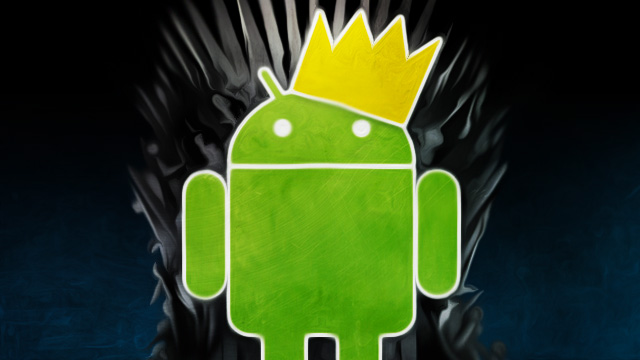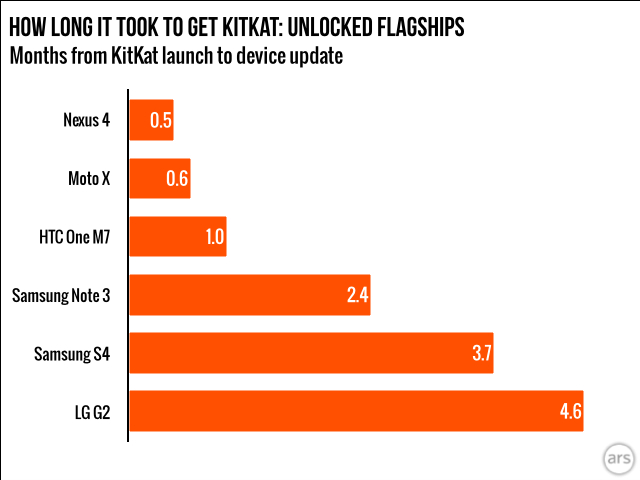
Android 4.4, KitKat was released on October 31, 2013, or at least, that's what you can say about one device: the Nexus 5. For the rest of the ecosystem, the date you got KitKat—if you got KitKat—varied wildly depending on your device, OEM, and carrier.
For every Android update, Google's release of code to OEMs starts an industry-wide race to get the new enhancements out to customers. So how did everyone do this year? Who was the first with KitKat, and who was the last? What effect does your carrier have on updates? How has the speed of Android updates changed compared to earlier years?Given all those variables, we wanted to check in on the specifics of Android in 2014. There are lots of slightly different ways to go about measuring something like this, so first, a word about our methodology. All of these charts measure KitKat's update lag time in months. For our start date, we're picking October 31, 2013, the day KitKat was released on the Nexus 5. For our finish time for each device, we're going with the US release of an update via either OTA or downloadable system image. OTAs are done on a staggered release schedule, so it's hard to tell exactly when they start and finish—we just went with the earliest news of an update.
The device manufacturers

The above chart shows the definition of "flagship" we'll be using for most of this article. We picked the newest high-profile devices that didn't ship with KitKat from each major OEM. That subset ends up being devices that largely launched in 2013. We single out flagships because those are the most exciting phones and the most relevant examples of a company's update policy—it's good to see how well an OEM can do when it is trying its hardest to update something quickly. (Don't worry, we'll tackle older devices and non-flagships later on.)
The winner for update times is, of course, the Nexus line. Stock software and a head start from being Google got KitKat out the door in just 14 days.
As for everyone else, how quickly they update seems to depend on how complicated their skin is and how much they take advantage of the update mechanisms Google has created.
Motorola—A beacon of light in the darkness
In the wide world of non-Nexus devices, the then-Google-owned Motorola did great, too, coming in at an almost-Nexus-like time of 19 days. Like the Nexus program, Motorola was helped out by a close-to-stock software loadout and a focus on a small number of devices. Motorola keeps most of its changes to bundled apps, and it tries to stay away from modifying the Android framework. When it comes time to update to a new version of Android, this means much less porting is needed. Google works very hard to not break app compatibility, so most of Motorola's work gets done for it.
The usual justification for skinning Android is "differentiation," and Motorola even manages to do that better than its competitors. The Moto X's always-on voice recognition and Active Display are some of the most useful differentiators in the industry, and the excellent Motorola Spotlight Player adds a bit of exclusive fun to the equation, too.Motorola takes full advantage of the Play Store, allowing for out-of-cycle updates for Motorola's bundled apps. The company even mirrors Google's Play Services strategy by offloading core libraries and services to the Play Store. There's Motorola Contextual Services, which handles detection for the automatic do not disturb, driving, and home modes, and Motorola Modality Services, which helps out accelerometer-driven apps.
Motorola is a shining example of "doing it right" when it comes to skinning Android; every other OEM should be taking notes.
Now, there is some confusion here—no one is quite sure of how much of Motorola's update success is from Google's ownership. With the pending sale to Lenovo, Motorola's future hangs in the balance. Will Motorola be able to continue its stellar track record of updates in the future, or will Lenovo ruin a good thing?
HTC—Transparency that should be applauded
HTC did surprisingly well getting KitKat to the unlocked One M7 in about a month. The company has come a long way since the disastrous days of the HTC Thunderbolt, and it has put a big focus on its update speed.
HTC hosts a software update dashboard that shows what developmental stage an update is in. The company has committed to supporting its North American flagships with updates for two years, promising to ship Android L to all variants of the One M7 and M8 within 90 days of its release. (HTC promised the same of KitKat and later apologized when it didn't quite make the 90 day cut, but still, we appreciate the effort.)HTC has a tighter focus on products lately, relaxing from its frantic pace of over two-dozen models in 2011 to just a handful of products this year. The company has also worked to make its Android skin, HTC Sense, more modular, offloading many apps to the Play Store the same way Google and Motorola do. The company even has a Google Play Services-style app called "HTC Service Pack," which allows it to update parts of Sense without having to push out an OTA.
Samsung—A monolithic skin that takes a while to update
Samsung easily sells the most Android devices, making its update speed the most important for the health of the overall OS ecosystem. It's a shame then that the company does very little to speed up the update process. Samsung uses a heavy monolithic skin with none of the update-friendly architecture that is employed by its competitors. TouchWiz extensively modifies the Android framework to make things like split screen apps, pen input, and floating windows possible. It skins every area of the OS and maintains a plethora of apps that duplicate Google functionality while providing seemingly little benefit to the user.
The worst part is that all of this is delivered to the user in a giant brick. Samsung doesn't take advantage of the Play Store to update apps and services outside of an OTA, because everything is so integrated with the core OS.
Samsung also has the widest lineup of all the Android OEMs. Its strategy seems to be to flood the market with as many different models as possible—GSM Arena's phone database lists 41 different Android phones (not including tablets) released by Samsung in 2013. It's pretty much impossible to update that many devices in a timely manner.
It should come as no surprise that the Note 3 took twice as long as the HTC One to get KitKat, and the Galaxy S4 was almost four times slower than HTC's effort. That's not even counting Samsung's 26 other lower-profile Android phones or its piles and piles of tablets.
LG—A minimal effort
LG came in dead last with a whopping 4.6-month wait for KitKat on the unlocked G2. You would think the maker of the last two Nexus phones would have picked up a thing or two from Google, but like Samsung, LG has an old-school monolithic skin and takes its sweet time updating it.
For the chart above, we picked unlocked phones so we would have a baseline that was unaffected by carrier red tape. Interestingly, the unlocked G2 wasn't the first G2 to get KitKat. That honor goes to the AT&T G2, which took 3.8 months. That's still last, but it's not as brutal of a loss for LG as it is with the unlocked model.
LG skins often feel like a copy of Samsung's TouchWiz, and LG has inherited TouchWiz's heft as well. Every app on the G2 has been skinned, and complicated changes are made to the framework to enable split screen apps and floating windows. The company clearly didn't put much effort into updating the G2 quickly.
With LG shipping a personal-best 14.5 million smartphones in Q2 of 2014 (Samsung shipped 74.3 million in the same period), we'll have to see if LG ups its update game in response to growing popularity.
reader comments
127